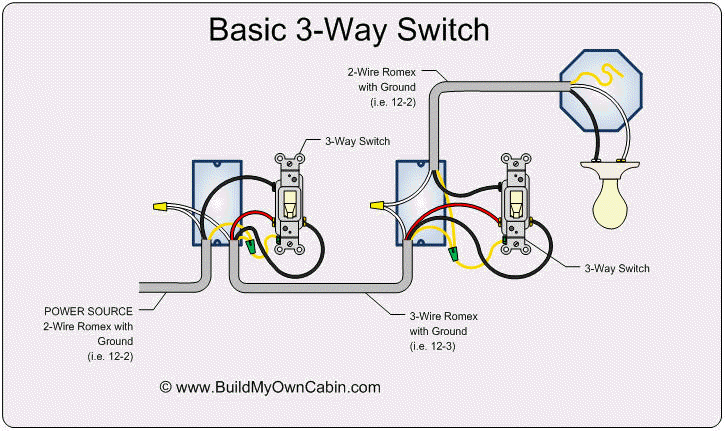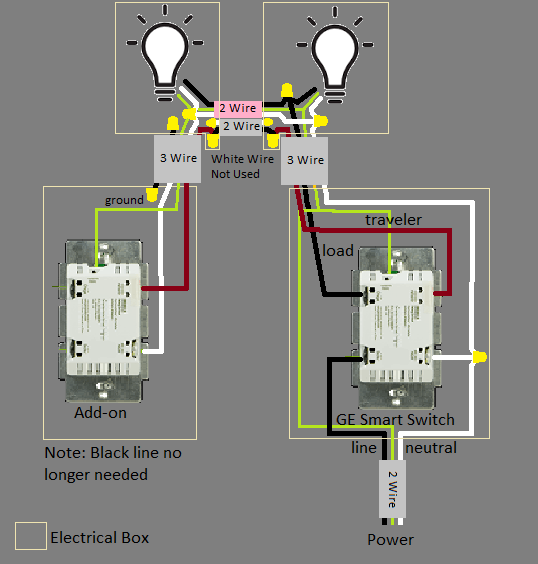I’ve decided to put this FAQ together to help those with questions about installing GE 3-way switches.
Definitions of terms:
Line: The hot wire from the breaker (usually black)
Neutral: The return wire for circuits (usually white)
Load: The wire that will be hot when the circuit is completed to your light (usually black)
Traveler: In existing 3-way wiring, this wire toggles hot between two switches. In a smart switch 3-way configuration, a smaller charge is looped through the add-on switch.
Some things to know:
- 3-way wiring for smart switches is different than standard 3 way wiring.
- You cannot use dumb 3-way switches with most smart switches (You must purchase the matching GE add-on switch to wire with your GE smart master switch).
- If the line is wired into the light fixture, you will not be able to use GE Smart Switches in a 3-way configuration without running additional wires. There are other smart options available listed below.
Recommendations before beginning:
- ALWAYS power off your circuit breaker before working with electricity. Only a tenth of an amp can kill.
- Please do not use ground as a neutral. You may end up with a current where it does not belong and it is against code.
- Take pictures of the existing wiring before starting. Those pictures are a good reference point and can assist those giving advice in the community.
- The community is a great place to ask questions or advice.
- Purchase a multi-meter or power wand to help determine which wires are line, load, traveler and neutral
- Existing wiring configurations can come in all shape and sizes - Usage of colors may not be standard.
- If you don’t feel comfortable with any of this - hire a professional.
NOTE: There is now a Z-Wave plus GE Dimmer (model 14299) that does not need neutrals. It will not work with LEDs and is only designed for incandescent loads. This FAQ is for standard models needing neutrals.
There is also a helpful thread about switches and wiring in general:
Wiring Configurations:
line-switch-switch-load
If your wiring is like either diagram below, you can wire your smart switch in either of your two switch boxes. Having multiple lights wired in parallel will not change your wiring. You should only need to change the wiring in each switch box (light box(es) do not need to be touched).
Option 1:
Option 2:
line-switch-load-switch-1
If your wiring is like the diagram below, you can wire your smart switch in the box with line. Having additional lights wired in parallel will not change the wiring below. You should only need to change the wiring in each switch box (light box(es) do not need to be touched).
Only Option:
line-switch-load-switch-2
If your wiring is like the diagram below, you can wire your smart switch in the box with line. You will need to change the wiring in both switch boxes and your light box.
Only Option:
line-switch-load-load-switch
If your wiring is like the diagram below, you can wire your smart switch in the box with line. You will need to change the wiring in both switch boxes and your light boxes.
Only Option:
Other wiring configurations that are not supported with GE 3-way switches:
Unfortunately with either of these configurations you do not have an available neutral for GE smart switches. You can however use other options.
You will need to use a relay installed in the light box or additional wires for the image above. Another option is Lutron Caseta, GE’s 14299 Dimmer, or Leviton’s ZSS10-G0Z switches that do not require neutrals.
For this type of wiring you can use relays or switches by Cooper or Linear which do not require a traveler. Another option is Lutron Caseta, GE’s 14299 Dimmer, or Leviton’s ZSS10-G0Z switches that do not require neutrals.
Another thing to note is that Zooz now makes Z-Wave Plus switches (demarked as version 2.0) which are wired the same as dumb 3-way switches. They are available in paddle and toggle formats.
Obviously, as mentioned above, your wiring may still differ from these common 3-way wiring standards. Feel free to ask any questions.
















